Dog
| I | INTRODUCTION |
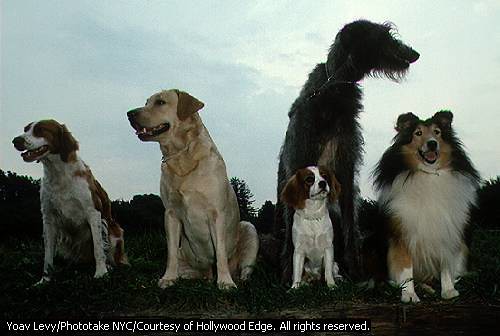
Domestic Dogs
The domestic dog, Canis lupus familiaris, believed to be a direct descendant of the wolf, Canis lupus, has been selectively bred into hundreds of different breeds.
Yoav Levy/Phototake NYC/Courtesy of Hollywood Edge. All rights reserved.
Dog, mammal generally considered to be the first domesticated animal. This trusted work partner and beloved pet learned to live with humans more than 14,000 years ago. A direct descendant of the wolves that once roamed Europe, Asia, and North America, the domestic dog belongs to the dog family, which includes wolves, coyotes, foxes, and jackals. Dog ancestry has been traced to small, civet-like mammals, called miacis, which had short legs and a long body and lived approximately 40 million years ago.
The evolving relationship between the domestic dog and humans has been documented in fossil evidence, artifacts, and records left by earlier civilizations. Prehistoric dog skeletal remains, excavated from sites in Denmark, England, Germany, Japan, and China, indicate the early coexistence of dogs with people. An ancient Persian cemetery, dating to the 5th century bc, contained thousands of dog skeletons. Their formal burial and the positioning of the dog remains reveal the esteem in which the ancient Persians held their dogs. The relationship shared by dogs and humans also is evident in cave drawings, early pottery, and Asian ivory carvings that depict dogs. A statue of Anubis, the half dog, half jackal Egyptian god, was discovered inside King Tutankhamen’s tomb, constructed in about 1330 bc.
Literary references to the dog include those found in the Bible and in the Greek classic the Odyssey by Homer. In 1576 an English physician and dog fancier, John Caius, wrote a detailed text on dog breeds, Of English Dogges. Dogs are featured in tapestries that were created in the Middle Ages (5th century to 15th century), and in the work of many artists, including 17th- and 18th-century European painters Peter Paul Rubens and Thomas Gainsborough.
Although it is not known how humans and dogs first learned to coexist, people soon discovered the many ways dogs could enrich their lives. Dogs have been used to hunt for food, herd animals, guard livestock and property, destroy rats and other vermin, pull carts and sleds, perform rescues, and apprehend lawbreakers. They have been used during wartime as sentinels and message carriers. Today trained dogs are used to alert deaf people to common household sounds, such as the ringing telephone or doorbell; guide the blind; or retrieve objects for quadriplegics. Perhaps the most common of the many roles served by the domestic dog, however, is that of companion. As animals with strong social tendencies, dogs typically crave close contact with their owners. And people tend to form loving bonds with dogs. This companionship often helps to ease the pain and isolation of the elderly or people whose physical or mental health requires long-term convalescence or institutionalization.
| II | PHYSICAL CHARACTERISTICS |

Dog Skeleton
A dog’s skeleton enhances agility and endurance. The strong front legs bear more than 60 percent of the animal’s weight, yet still permit flexibility and nimbleness. The hind legs, attached to massive muscles, enable powerful acceleration and help to maintain running speed.
© Microsoft Corporation. All Rights Reserved.
Domestic dogs vary widely in appearance, particularly in size. The Shih Tzu, for example, is 20 to 28 cm (8 to 11 in) in length and weighs 4 to 7 kg (9 to 15 lb). The Irish wolfhound is at the other end of the scale, measuring about 71 to 94 cm (about 28 to 37 in) at the shoulder and weighing up to about 61 kg (about 135 lb). Coat color, length, texture, and pattern also vary greatly. The muzzle may appear shortened, as in the Pekingese, or elongated, as in the Doberman pinscher. Limbs are relatively short in the basset hound and dachshund, but long in the greyhound. Ear shape and carriage also vary, but these characteristics may be influenced by a dog owner’s decision to crop, or cut, the ears to make them stand up. Some dogs, notably the chow chow, even have a naturally blue-black tongue.
Despite these differences, all breeds of the domestic dog are essentially identical in anatomy. The skeleton of the domestic dog has an average of 321 bones, with variation reflecting differences in the number of bones in the tail and the presence of a dewclaw, an extra digit on the paw that not all breeds have. The rib cage consists of 13 pairs of ribs; the spine has 7 cervical vertebrae, 13 thoracic vertebrae, 7 lumbar vertebrae, and 3 sacral vertebrae. Rear paws have four complete digits and front paws have four or five digits. Most puppies have 28 temporary teeth, which are replaced with 42 permanent teeth at about six months of age.
Some breed differences evolved to help dogs survive in their native environment or occupation. For example, dogs that lived and worked outdoors, such as the Komondor of Hungary, needed a thick, weather-resistant coat to protect them from the elements and, perhaps, the biting teeth of predatory animals. Similarly, the Labrador retriever developed an oily coat, webbed feet, and a rudder-like tail to help it perform better in recovering downed waterfowl.
Just as distinct physical characteristics became trademarks in some breeds, unusual sensory abilities characterize others. Most dogs are able to detect scents and hear high-pitched sounds that are beyond human perception, but some breeds have especially acute sensory skills. The bloodhound, for instance, can follow a four-day-old track using its highly developed sense of smell. Other breeds with a keen sense of smell include the German shepherd, golden retriever, beagle, and Newfoundland. These dogs have been trained for such varied duties as detecting hidden drugs, explosives, termites, and even a decomposing body immersed in deep water.
| III | REPRODUCTION, BIRTH, AND THE YOUNG |
Dogs generally reach sexual maturity at about six months of age, with small breeds often maturing earlier than large breeds. Female dogs, or bitches, become sexually receptive to mating during a period called estrus (also called season or heat), which occurs about twice a year for 6 to 12 days. After a gestation period of about 63 days, an average litter of three to six puppies is born.
Blind and unable to stand, newborn puppies are helpless and spend 90 percent of their time sleeping and 10 percent nursing. Becoming chilled is the greatest danger facing a healthy newborn puppy because its immature circulatory system cannot sustain an adequate body temperature. For this reason, newborn puppies tend to stay close to their mother or cuddle together for warmth. Mothers clean, nurse, and defend their pups until they can live on their own, but fathers do not involve themselves in the care of the young.
| IV | DOG BREEDS |

Cairn Terrier
Cairn terriers originated on the Isle of Skye, off the coast of Scotland. Skilled and courageous working dogs, old-world cairn terriers would bolt rodents and small mammals from cairns, or piles of rocks. Modern breeders of the dogs attempt to preserve the character of old-world cairn terriers.
Dorling Kindersley

Norwegian Elkhound
The Norwegian elkhound is a breed of hunting dog. The breed is characterized by a short, strong body, a broad chest, a thick coat, and a curled tail.
Robert and Eunice Pearcy/Animals Animals
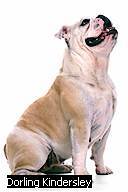
Bulldog
The bulldog was originally bred for the sport of bullbaiting; after the sport was banned, the bulldog was bred once again to lose its viciousness. The bulldog is often considered a mascot of the British.
Dorling Kindersley
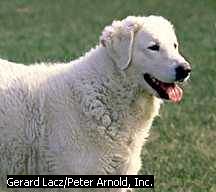
Kuvasz
The kuvasz is a breed of working dog originally bred as guard dogs in Europe. This large breed is characterized by strong muscles and a white coat.
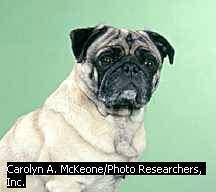
Pug
A pug is a breed of toy dog characterized by a wrinkled forehead and flat, black nose. Its short hair can be solid black or light- colored with black markings on the face and ears.

Groenendael Belgian Sheepdog
Its black color distinguishes the Groenendael variety of Belgian sheepdog from the three other varieties—the Belgian Laekenois, the Belgian Malinois, and the Belgian Tervuren. Although sheepdogs were first developed in the 1200s, the Groenendael breed, also known simply as the Belgian sheepdog, was not created until the late 1800s, when the owner of a café in Groenendael, Belgium, mated two black sheepdogs. The Belgian sheepdog is often used to herd and guard farm livestock.
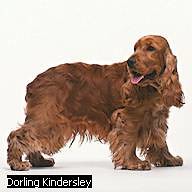
Cocker Spaniel
The cocker spaniel has long been bred for hunting and may have been named after a primary prey, the woodcock. Hunters valued the dog for its intelligence and trainability. These qualities serve domestic pet owners as well, contributing to the breed’s popularity as a pet.
Dorling Kindersley
| V | DOG BEHAVIOR |
Instinctive behaviors of the domestic dog are comparable to those of its wild relatives, the wolf, coyote, fox, and jackal. Unlike trained behaviors, such as being housebroken or responding to human commands, instinctive behaviors are those that dogs do without being taught and include vocalizations, body language, and marking. For example, by four weeks of age, puppies bark, whine, growl, and howl—-just like their wild relatives. Even the African Basenji, known as the barkless dog, yodels when aroused. These sounds, whether elicited in excitement, fear, territoriality, or pain, are one way that dogs communicate with one another and with other animals and people.
Dogs also communicate through their use of body language. Facial expression, ear posture, tail carriage, hackle (hair on back) display, and body stance signal a dog’s state of fear, excitement, aggression, or submission. Understanding the meaning behind these signals can be important. Signs of potential hostility in a dog include bared teeth, flattened ears, erect tail, stiff legs, and bristling back hair; the dog may also growl or bark. People observing these behaviors should keep their arms at their sides and slowly back away, while firmly saying “no.” When approaching a strange dog, first ask the owner if the dog may be touched. Once given permission, hold the hands low and speak softly. Staring directly at a dog may arouse intimidation or aggression, so eye contact with strange dogs should be avoided.
Dogs typically mark their territory with urine as part of the social communication between animals in general and among the species. A dog may defend the territory by growling, barking, or assuming aggressive body language.
In addition to these instinctive behaviors, dogs are capable of learning certain trained behaviors, such as following obedience commands. The domesticated dog is able and willing to learn appropriate behaviors and is highly motivated to please its owner, critical factors that have contributed to the success of the domestic dog as a companion.
| VI | CARING FOR A DOG |
The decision to adopt a dog should be made carefully because it is a serious commitment that can last for several years. Small dogs may live 12 or more years, although very large dogs typically have a shorter lifespan, sometimes as brief as 8 years. Before buying a dog, potential owners should examine their lifestyle, living accommodations, and plans for the dog. Other decisions should include who, in the case of a family, will care for the dog and whether the family or individual owner will have enough time, attention, and money to meet the dog’s needs.
For example, a busy family might not have the necessary time to groom a dog with a thick coat, and some people might be unwilling to keep up with the frequent vacuuming needed with a breed that sheds large amounts of hair. Further, a large dog that requires lots of exercise would not thrive in a small apartment, nor would a tiny dog be safe around very young children, who may be too rough with these dogs. Potential owners also should decide which gender dog they prefer and if it will be used for breeding. Another decision is to determine if the dog will be a show dog, a working dog, or a pet because this will influence which individual to select. Finally, anyone who would like to acquire a dog should be sure to budget for its food; medical expenses, which will cover immunizations, check-ups, and sick visits; and any kennel care required in the owner’s absence.
Many people prefer a purebred dog so that they can predict how the dog will look and act when fully grown. Most veterinarians and responsible dog fanciers believe that a private breeder with a good track record in producing healthy puppies is the best option for choosing purebreds. To locate a breeder, check the newspaper, visit a dog show, contact a veterinarian or experienced acquaintance, or call a local kennel club or the AKC. Visit several breeders and meet each litter’s dam (mother) and sire (father), if possible. Be prepared to ask, and answer, a lot of questions. Reputable breeders vigorously screen prospective buyers to ensure that their puppies go to good homes. Other potential owners are satisfied with mixed-breed dogs, called mongrels or mutts. Animal shelters and humane societies, veterinarian offices, and classified advertising are all resources for finding a mixed-breed that meets the needs of a potential owner.
When adopting a puppy, wait until it is at least eight weeks of age before separating it from its mother. Although the various breeds, and dogs in general, have different temperaments, look for a clean puppy that is happy, outgoing, and alert. A puppy that is excessively shy or thin or that has obvious health problems, such as discharge from its eyes or nose, is not a good choice.
A new puppy should be taken to a veterinarian soon after adoption for a thorough physical examination and to ensure that it is current on vaccinations. All puppies need a series of immunizations to protect them against distemper, a viral disease that causes respiratory symptoms and can affect the nervous system; leptospirosis, a bacterial disease that damages the liver; hepatitis, a viral disease that also targets the liver; parvovirus, which harms the intestinal tract; and parainfluenza, which causes respiratory problems. Immunizations for these five diseases are usually administered in one vaccination. Dogs also need rabies shots to protect them from this virus, which is transmitted in the saliva by the bite of an infected animal and attacks the nervous system. Some owners opt for additional vaccinations against Lyme disease, a bacterial infection that is transmitted by parasitic deer ticks; kennel cough, a respiratory disease caused by the bordatella bacteria; and coronavirus, which targets the intestinal tract.
Most young puppies harbor roundworms, intestinal parasites that are diagnosed by examining a stool sample. Roundworms rob the puppy of nutrients, resulting in the puppy’s failure to thrive; the parasites are eliminated with several doses of oral medication. Dogs of all ages should follow a drug regimen to protect them from another parasite, heartworm, which damages heart tissue, obstructs blood flow, and often causes death. The veterinarian should also discuss spaying or neutering (making a dog infertile), which are essential in nonbreeding dogs to protect their health and reduce the population of unwanted dogs. This common surgical procedure is usually not done until a pup is six months old.
Veterinarians recommend that dogs of all ages have a yearly checkup, including vaccination booster shots and screening for external and internal parasites. Since dogs cannot communicate their health problems through words, an annual examination is important for the early detection and treatment of problems. Owners should be aware of signs of possible illness requiring veterinary attention, including changes in appetite and behavior.
All puppies and dogs have three daily requirements: plenty of fresh drinking water, correct amounts of nutritious food, and adequate exercise for the dog’s age, breed, and temperament. An outdoor dog needs shelter from the elements and plenty of shade during the summer months, and indoor pets must have regular access to the outdoors for elimination. Whatever their living arrangements, all dogs require the loving attention of their owners.
Grooming considerations vary from breed to breed. Short-coated dogs usually need to be brushed once or twice a week, whereas long-haired dogs may need daily grooming to prevent the coat from matting or tangling. Dogs need only be bathed when dirty, and the shampoo used should be one that will protect the coat’s natural oils. Grooming also includes attending to the dog’s eyes, ears, teeth, anal glands, and nails; details of such care, however, should first be explained by a veterinarian.
| VII | TRAINING YOUR DOG |
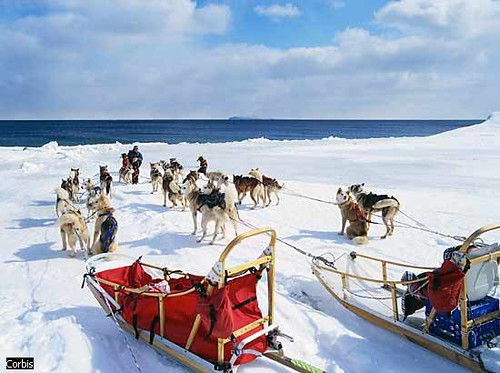
Dogsledding
Dogs are often used to drive sleds, such as these sled dog teams in Canada’s Northwest Territories.
Corbis
Training is another vital part of raising a happy and healthy dog. All dogs should be trained to walk on a leash and be housebroken. Some people prefer housebreaking a puppy by training it to urinate and defecate on newspapers, which are laid flat in a small area such as a foyer. The puppy is rewarded each time it voids on the paper; then the newspapered area is gradually reduced and finally eliminated altogether. However, crate training, in which a dog is confined to a crate for limited periods, is more effective because dogs will avoid soiling their own living quarters. Whichever method is chosen, housebreaking should begin as soon as a puppy comes home with its new owner, who should provide the puppy with frequent opportunities to urinate and defecate outside. In general, pups are not completely housebroken until they are at least 12 weeks old.
Most puppies are ready to begin obedience lessons at six to eight months of age. The first lessons should be relatively brief, about 10 to 15 minutes a day, and gradually increase to 30 minutes, depending on the dog’s level of concentration. Training is best accomplished with lots of praise and a stern “no” for corrections. The trainer should always be consistent in reinforcing good behavior and correcting bad behavior and should never strike a dog. Many trainers use a leash and chain-link collar, known as a choke collar. Despite its name, the collar is never meant to choke a dog, but is used to deliver quick snaps to gain and direct a dog’s attention. This training collar is useful in teaching basic obedience commands, such as sit, stay, heel, come, and down.
| VIII | DOG SHOWS |
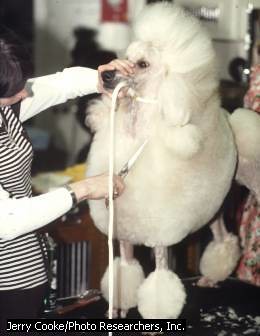
Poodle Clipping
A poodle submits to having its fur trimmed. The clipping of poodles originated as a method of reducing drag while the dog was swimming. Trimming is often a requirement for dogs that are entered in shows.
Jerry Cooke/Photo Researchers, Inc.
In the United States, the AKC sponsors 14,000 competitive dog shows and performance events each year. Dog show judges evaluate a dog’s conformation to its breed standard—an official physical description of the ideal specimen for a particular breed—and compare the dog with other dogs at the show. Most show dogs are competing for points toward their championship. At a large dog show, such as the Westminster Kennel Club show held over two days in New York City each February, a field of thousands of dogs is progressively thinned to a single Best in Show winner.
A variety of performance events are held that seek to provide dogs with an opportunity to perform the function for which they were originally bred. For instance, a saluki, a hound dog, may enter a lure coursing event to demonstrate its skill at pursuing swift prey. Small terriers may vocalize and lunge into a tunnel after “quarry” at an earth dog trial. Bloodhounds may follow a scent laid down by handlers at a tracking test. The puli, a herding dog, may gather a flock of sheep at a herding trial. Many performance events offer increasing levels of difficulty that are reflected in a range of titles. Once earned, these titles are entered into a dog’s permanent AKC record. Whether people choose to enter their dogs in formal competition, work with them, or simply enjoy their companionship, all dogs thrive on the bond that is fostered by a caring owner.
Contributed By:
Elizabeth M. Bodner
Microsoft ® Encarta ® 2007. © 1993-2006 Microsoft Corporation. All rights reserved.

Great post!! Elite Speed Dating are dating events for graduates and professional people of all ages. We currently run the following events.
ReplyDelete--------
sig, m.d.
Elite Speed Dating
Speed Dating Manchester
Speed Dating Liverpool
Speed Dating Leeds
Speed Dating Chester
Speed Dating Wilmslow